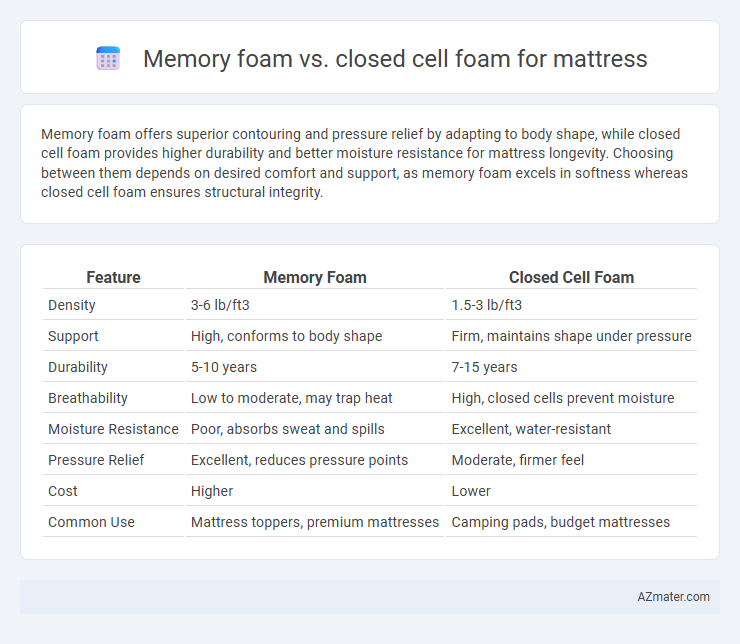Memory foam offers superior contouring and pressure relief by adapting to body shape, while closed cell foam provides higher durability and better moisture resistance for mattress longevity. Choosing between them depends on desired comfort and support, as memory foam excels in softness whereas closed cell foam ensures structural integrity.
Table of Comparison
| Feature | Memory Foam | Closed Cell Foam |
|---|---|---|
| Density | 3-6 lb/ft3 | 1.5-3 lb/ft3 |
| Support | High, conforms to body shape | Firm, maintains shape under pressure |
| Durability | 5-10 years | 7-15 years |
| Breathability | Low to moderate, may trap heat | High, closed cells prevent moisture |
| Moisture Resistance | Poor, absorbs sweat and spills | Excellent, water-resistant |
| Pressure Relief | Excellent, reduces pressure points | Moderate, firmer feel |
| Cost | Higher | Lower |
| Common Use | Mattress toppers, premium mattresses | Camping pads, budget mattresses |
Introduction to Mattress Foam Types
Memory foam offers contouring support by responding to body heat and pressure, providing personalized comfort and pressure relief. Closed cell foam, known for its dense and durable structure, resists moisture and provides firm support with enhanced insulation properties. Both foam types serve distinct functions in mattresses, catering to varying preferences in comfort, durability, and temperature regulation.
What is Memory Foam?
Memory foam is a viscoelastic material known for its superior pressure-relieving properties and ability to contour closely to body shapes, enhancing comfort and support in mattresses. Unlike closed cell foam, which consists of rigid, air-trapped cells providing firm support and moisture resistance, memory foam responds to heat and pressure by softening, thereby reducing stress on joints and promoting better spinal alignment. Its high density and viscoelasticity make memory foam an ideal choice for those seeking enhanced cushioning and adaptive support in sleep surfaces.
What is Closed Cell Foam?
Closed cell foam is a dense, rigid material characterized by tightly packed cells that trap air, providing superior insulation, durability, and water resistance compared to open cell foams. Unlike memory foam, which contours to the body and offers pressure relief, closed cell foam offers firm support and resists compression, making it ideal for mattress bases or layers requiring structural strength. Its moisture resistance and long-term shape retention make closed cell foam a durable choice for mattresses needing enhanced support and longevity.
Key Differences Between Memory Foam and Closed Cell Foam
Memory foam offers superior pressure relief and contouring by responding to body heat and weight, while closed cell foam provides higher durability and water resistance due to its dense, airtight structure. Memory foam excels in comfort and motion isolation, making it ideal for mattresses, whereas closed cell foam is favored for its structural support and resistance to moisture, often used in outdoor or high-impact applications. The key differences lie in their density, breathability, and response to pressure, with memory foam being softer and more adaptive, and closed cell foam being firmer and more resilient.
Comfort and Support Comparison
Memory foam mattresses excel in conforming to body contours, providing superior pressure relief and personalized comfort by evenly distributing weight and reducing motion transfer. Closed cell foam offers firmer support with its dense, resilient structure, enhancing durability and preventing sagging, ideal for users who prefer a more solid sleeping surface. While memory foam prioritizes softness and contouring support, closed cell foam delivers consistent edge support and breathability, balancing comfort with long-term firmness.
Durability and Longevity
Memory foam mattresses provide excellent durability due to their viscoelastic properties, which allow them to retain shape and support over time, typically lasting 7-10 years. Closed cell foam, known for its dense and rigid structure, offers enhanced longevity by resisting moisture, mold, and compression, often exceeding 10 years in lifespan. When considering durability, closed cell foam is superior for maintaining firmness and structural integrity, while memory foam delivers consistent comfort with moderate durability.
Breathability and Temperature Regulation
Memory foam excels in contouring to the body but often retains heat due to its dense structure, leading to reduced breathability and elevated sleeping temperatures. Closed cell foam features a more rigid, non-porous composition that resists moisture absorption but limits airflow, resulting in moderate breathability and temperature regulation. For optimal mattress performance, combining memory foam with advanced cooling technologies or hybrid designs enhances airflow and dissipates heat more effectively.
Allergies and Health Considerations
Memory foam mattresses typically resist dust mites and allergens due to their dense structure, making them suitable for allergy sufferers. Closed cell foam is inherently non-absorbent and resistant to mold and mildew, reducing health risks associated with moisture retention. Both foam types offer hypoallergenic benefits, but closed cell foam provides superior moisture barrier properties that enhance overall hygiene and minimize potential respiratory issues.
Price and Value Comparison
Memory foam mattresses typically cost more upfront due to their advanced pressure-relieving properties and durability, with prices ranging from $800 to $2,500 depending on thickness and brand. Closed cell foam mattresses are generally more affordable, priced between $300 and $1,200, offering excellent water resistance and support but potentially less long-term comfort and resilience. Choosing between the two depends on budget constraints and desired value, where memory foam often delivers better pressure relief and longevity for a higher price, while closed cell foam provides cost-effective durability with less contouring ability.
Which Foam is Best for Your Mattress Needs?
Memory foam offers superior contouring and pressure relief, making it ideal for individuals seeking personalized comfort and support, especially those with joint pain or back issues. Closed cell foam provides higher durability, water resistance, and firm support, suitable for people needing a resilient mattress with better breathability and moisture control. Choosing the best foam depends on your sleep preferences, body type, and whether you prioritize softness and pressure relief (memory foam) or durability and moisture resistance (closed cell foam).

Infographic: Memory foam vs Closed cell foam for Mattress
 azmater.com
azmater.com